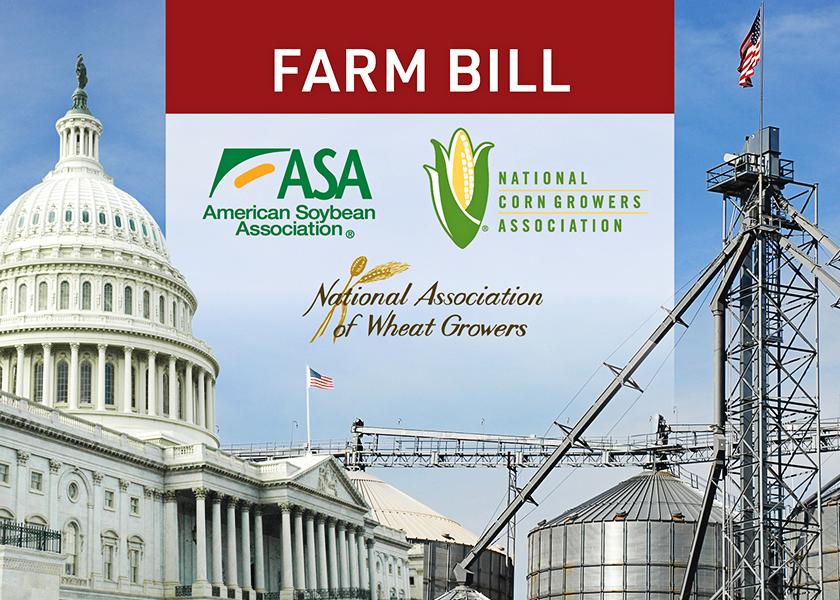The Cost of a Farm Bill: 2023 Row Crop Priorities

The 2018 farm bill was stamped with a $428 billon price tag when the bill was passed. Nutrition, crop insurance, commodities, trade and conservation programs were among the programs to receive the most funds.
With the 2018 bill set to expire on Sept. 30, the Congressional Research Service last May released baseline spending for the same programs starting in the 2023 farm bill. The baseline shows a decrease in commodities and conservation, while nutrition, trade and crop insurance increased.

As the debate heats up, here’s a breakdown of what ag groups look to push on the 2023 farm bill negotiating table:
1. Crop Insurance
Industry leaders sounded the crop insurance alarm on the The Hill in Jan. when some 60 groups signed a letter to Senate and House Ag Committee members, pushing for protections from “harmful” insurance cuts.
“Farmers spend as much as $4 billion per year of their own money to purchase insurance from the private sector. On average, farmers also must incur losses of almost 30 percent before their insurance coverage pays an indemnity,” the groups wrote in the letter. “Given the challenges faced by rural America and the critical nature of crop insurance, cuts to the program should be avoided.”
Crop insurance is permanently authorized in a farm bill. However, amendments are often posed to the crop insurance title, adding an element of concern for producers.
Leaders at the American Soybean Association (ASA) are looking to play defense in the title, says Christy Seyfert, ASA executive director of government affairs.
“In the past, amendments have been proposed to use crop insurance as a funding resource for priorities outside of crop insurance,” Seyfert says. “We’re looking to protect against harmful amendments that make crop insurance more expensive for farmers.”
Read more: Stepped-Up Basis Leaning in Favor of Rural America on House Ways and Means Panel
National Association of Wheat Growers (NAWG) is aiming to take a different approach.
“We’re looking to maintain and enhance the crop insurance reach for producers by expanding current authority and programs,” says Chandler Goule, NAWG CEO. “To help with continued market fluctuations and erratic weather patterns, we’re leaning more into the revenue side.”
2. Farm Safety Net
Most farmers who grow row crops will soon be making their decision between Agricultural Risk Coverage (ARC) and Price Loss Coverage (PLC).
The 2014 Farm Bill first introduced ARC and PLC with a reference price, while the 2018 Farm Bill allowed the reference price to increase by up to 15%, which is why it is now called the effective reference price.
This reference price should be a focus in 2023, according to Wayne Stoskopf, director for public policy for risk management and tax at National Corn Growers Association (NCGA).
“The effective reference price is definitely something we want to maintain,” he says. “We’re looking at how much it would cost, as well as some of the potential benefits, if it or the statutory reference price we’re to be increased.”
Read more: ARC or PLC - Which Do I Choose for 2023
Goule echoed Stoskopf, saying with the increase in the cost of goods, services and inputs since 2018, a $5.50 reference price for wheat is “simply not a realistic backstop” of what it costs to produce a bushel of wheat in the U.S.
“We’re encouraging Congress to increase budget authority so we can raise the reference price to something that’s reflective of our current circumstances and potential costs in coming years,” Goule says.
3. Trade
U.S. ag exports reached a record high of $196.4 billion in fiscal year 2022, according to USDA. With $237 million in funding for the Market Access Program (MAP) and Foreign Market Development Program (FMD) for 2023, Seyfert foresees another export record. However, her team thinks more funding could be impactful.
“We’re looking to double funding for MAP and FMD in the next farm bill,” she says. “A jump to $400 million and $69 million, respectively, will help us continue to build relationships internationally.”
Read more: SHIP IT Act Could Save Truck Drivers Up to $10,000 and Cover CDL Costs
According to Seyfert, ASA and other associations feel increased investments will open new doors to untapped markets overseas.







